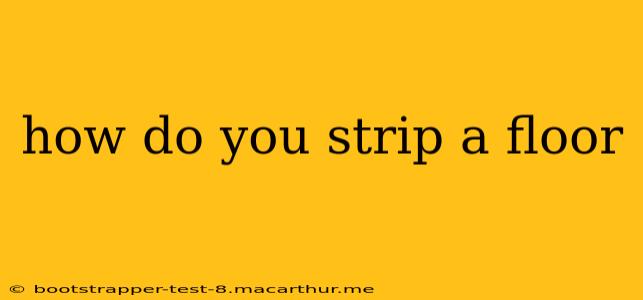How Do You Strip a Floor? A Comprehensive Guide to Floor Stripping
Stripping a floor is a challenging but rewarding task that can dramatically improve the look and longevity of your hard floors. Whether you're dealing with old, worn-out finish or preparing for a new coat of sealant, understanding the process is crucial for success. This guide will walk you through the entire floor stripping process, answering common questions along the way.
What is Floor Stripping?
Floor stripping involves removing old layers of finish, such as wax or sealant, from a hard floor surface, usually wood or concrete. This process is necessary to prepare the floor for refinishing or resealing, ensuring a smooth, even finish and extending the floor's lifespan. Improperly stripped floors can result in an uneven, patchy final result, so paying attention to detail is key.
What Supplies Do I Need to Strip a Floor?
Before you begin, gather the necessary supplies. This includes:
- Floor stripper: Choose a stripper appropriate for your floor type (wood, concrete, vinyl, etc.). Read the manufacturer's instructions carefully.
- Scrub brushes: These will help loosen and remove the old finish. Different brushes are suited for different floor types and finishes.
- Push broom or squeegee: To remove excess stripper and loosened finish.
- Wet/dry vacuum: Essential for removing the loosened finish and stripper solution. Consider a shop-vac for larger areas.
- Buckets: Multiple buckets are needed; one for the stripper solution, one for rinsing the brushes, and one for dirty water.
- Safety gear: Wear gloves, eye protection, and a respirator, as floor strippers can be harsh chemicals.
- Protective covering: Protect walls and furniture from splashes.
- Clean rags or mop: For wiping down the floor once the stripping is complete.
What's the Best Way to Strip a Floor?
The stripping process typically involves these steps:
-
Preparation: Clear the floor completely. Protect baseboards and walls with masking tape and drop cloths.
-
Applying the stripper: Follow the manufacturer's instructions on dilution and application. Usually, you apply the stripper in sections, allowing it to dwell for the recommended time (usually 15-30 minutes) to soften the old finish.
-
Scrubbing: Use a scrub brush to loosen and remove the softened finish. Work in small sections to avoid the stripper drying out.
-
Removal: Use a wet/dry vacuum or a push broom and squeegee to remove the loosened finish and stripper solution. Pay attention to corners and edges.
-
Rinsing: Rinse the floor thoroughly with clean water to remove all traces of stripper. This is crucial for preventing a reaction with the new sealant.
-
Drying: Allow the floor to dry completely before applying any new finish. This usually takes several hours or even overnight, depending on humidity and air circulation.
How Long Does It Take to Strip a Floor?
The time it takes to strip a floor depends heavily on the size of the area, the type of flooring, and the amount of old finish to remove. Expect to spend several hours or even an entire day for larger areas. Smaller spaces might take a few hours. Always allow sufficient drying time.
What Type of Floor Stripper Should I Use?
The type of floor stripper you need depends entirely on the type of flooring you have. Read labels carefully to ensure you're using a stripper specifically designed for your floor material (wood, concrete, vinyl, etc.). There are also strippers formulated for different types of finishes (wax, polyurethane, etc.).
Can I Strip a Floor Myself?
Yes, you can strip a floor yourself, but it's a physically demanding job requiring patience and attention to detail. If you're not confident in your abilities, it's best to hire a professional. Incorrect stripping can damage your floor and may require even more extensive (and expensive) repairs.
What Happens if I Don't Strip the Floor Properly?
Improperly stripped floors often lead to uneven application of new finishes, resulting in a patchy and unprofessional look. Residual stripper can react negatively with the new sealant, compromising its durability and longevity. In some cases, it may even be necessary to restart the entire process.
Remember always to prioritize safety by wearing appropriate protective gear. With careful planning and the right approach, you can successfully strip your floor and achieve a beautiful, long-lasting finish.
